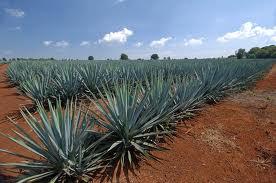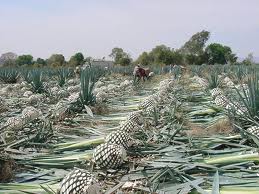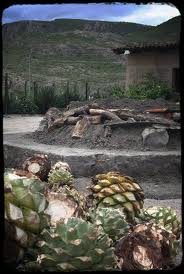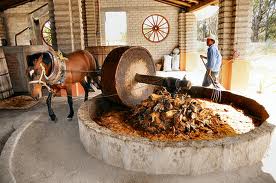I first published this post in 2012. At the time, mezcal was little known. And while the battle for recognition is still uphill, mezcal is far more popular today than it was back then. Since 2012, mezcal sales are up almost four times, and the vast majority of bars, restaurants and liquor stores, carry at least one brand.
I still spend a lot of time spreading the gospel of mezcal, and more times than not, the conversation begins with the comparison of mezcal to tequila. I use it as an opener at cocktail parties. I just walk up to a random person and ask them “Do you know what the difference is between tequila and mezcal?” They usually turn and walk away. OK, maybe that is not the way it goes down, but it could happen that way!
But this question usually is the starting point when people are curious about mezcal. In many ways, mezcal can best be understood by simply tasting it next to tequila. What will you find? Most notably, you will find mezcal to be smoky by comparison. Intense and smoky like a campfire to some, or subtle and gentle to others. The person who finds the smoke to be light is usually a scotch, bourbon or whiskey drinker, and is used to bold spirits. If you find mezcal to be intensely smoky, there is a good chance you are not accustomed to drinking spirits neat.
This post gives you the basics, but if you really want to understand and appreciate what separates mezcal from tequila, you need to read my book Holy Smoke! It’s Mezcal! (shameless self-promotion perhaps, but hey, the blog is free so this is my form of selling ad space!). The book is available on Amazon. Notice the cool cover shot to the right. Buy a copy – I promise you won’t be disappointed! Now back to our regularly scheduled program…
I believe that for most people tequila leads to mezcal (even though all tequilas are mezcals, but we will come back to that). Tequila leads to mezcal because for most of us, it started with tequila. We traveled down a path that likely started with bad tequila, bad experiences, and bad results the next morning. Then we slowly found our way back to the good 100% agave tequilas that started showing up in the 90’s. And maybe we enjoyed the extra anejos that move tequila toward cognac. And then, what? What else is out there? Ahhh mezcal….I’ve heard about that. The rise of the extra anejos coincided with the arrival of fine mezcals and then they started to appear on the shelves at your local liquor store and on the cocktails menus of your favorite gin joints. So tequila brought us to this point and now mezcal joins the discussion….
There are three key reasons why mezcal is different from tequila:
- Tequila and mezcal are produced in different states of Mexico (though there is overlap).
- Tequila can only be made, by law, with one variety of agave: the Blue Agave. Mezcal can be made with upwards of 50 varieties of agave, though most are made with the Agave espadin.
- The production process for mezcal is different from tequila which leads to a distinctly different flavor profile for mezcal.
Tequila and Mezcal are Produced in Different Regions
First, you must know that all tequilas are mezcals. Mezcals are any agave-based liquor, and therefore tequila is a subset of mezcal produced in specific regions of Mexico and made only from the Blue Agave. Tequila is made in 5 specific regions: Jalisco, Michoacan, Guanajuato, Nayarit, and Tamaulipas. Jalisco is definitely the center of the tequila universe and where the town of Tequila (yes, there is a town named Tequila) is located.
Mezcal is made in 9 specific regions of Mexico: Oaxaca, Durango, Guanajuato, Guerrero, San Luis Potosi, Tamaulipas, Zacatecas, Michoacan, and Puebla. Oaxaca is the center of the mezcal world, as about 80%% of mezcals are made in Oaxaca. In the summer of 2018, 3 new states were provisionally approved to produce mezcal (México, Aguascalientes, and Morelos). The extension of the mezcal Denomination of Origin to these states is currently being challenged, so they may or may not make it to official status.
Tequila and Mezcal are Made From Different Varieties of Agave
Tequila must be made from the Blue Agave. Mezcal, on the other hand, can be made from more than 50 varieties of agave, including the Blue Agave. See my previous post on How Many Agave Varieties Can Be Used To Make Mezcal for a lengthy, and some say fascinating (maybe that’s just me) discussion. But know that most mezcals are made from the Agave Espadin, which is the most prevalent agave variety found in Oaxaca.
The Production Process is Different
You’ve seen agave plants, right? They have these long spear-like leaves. At harvest, the leaves are sheared off by the jimador (the person doing the harvesting) who uses a coa, a long-handled stick with a sharp, flat blade at the end. Once the leaves are off, what is left is called the “pina” because it looks like a large pineapple.
They have these long spear-like leaves. At harvest, the leaves are sheared off by the jimador (the person doing the harvesting) who uses a coa, a long-handled stick with a sharp, flat blade at the end. Once the leaves are off, what is left is called the “pina” because it looks like a large pineapple. 
Up until this point, a tequila harvest and a mezcal harvest is essentially the same (with different varieties of agave). How the pina is cooked is where the process differs dramatically.
With tequila, the pinas are cooked in large industrial ovens, known as autoclaves, which are large, stainless-steel industrial pressure cookers. (note: there are other methods of cooking and crushing the pinas but this is the most common). Then the cooked agave is shredded and fermented blah blah blah. So uninteresting. So industrial. So mass production. So boring! (Can you feel the mezcal bias brewing?)
With artisanal mezcal, the process is much more handcrafted and follows the process that has been used for hundreds of years. I stress the word “artisanal” because some mezcals, like Kimo Sabe (which sucks, by the way), use a very industrial process much like a mass-produced tequila. But the premium mezcals, which I regularly discuss on this blog, use the traditional production method. With artisanal mezcal production, the pinas are cooked in an underground, earthen pit. The pit is typically about ten feet wide and t en feet deep, and cone-shaped down to the bottom. It is lined with volcanic rock. A fire is started in the bottom with wood. This fire burns to the embers heating the volcanic rocks to extreme heat. The pinas are then piled into the pit and covered with about a foot of earth. This underground “oven” now smokes, cooks and caramelizes the pina over a multi-day cooking process. The picture on the left here shows a covered pit and the pinas are cooking beneath the earthen mound. The pinas in the foreground are for show (or perhaps, they are just happily waiting their turn at glory to be smoked and turned into glorious mezcal!). It is largely this underground baking process that imparts the smoky flavor to a mezcal.
en feet deep, and cone-shaped down to the bottom. It is lined with volcanic rock. A fire is started in the bottom with wood. This fire burns to the embers heating the volcanic rocks to extreme heat. The pinas are then piled into the pit and covered with about a foot of earth. This underground “oven” now smokes, cooks and caramelizes the pina over a multi-day cooking process. The picture on the left here shows a covered pit and the pinas are cooking beneath the earthen mound. The pinas in the foreground are for show (or perhaps, they are just happily waiting their turn at glory to be smoked and turned into glorious mezcal!). It is largely this underground baking process that imparts the smoky flavor to a mezcal.
The artisanal mezcal process continues once the pinas are cooked and unearthed. The crushing process for the agave is traditionally done with a tahona (pictured here). Yes, it is a horse or donkey pulling a large stone wheel around in a circle. You see the cooked agave being crushed in the center of the wheel. This is cool, hand-crafted stuff! This entire process basically happens on a farm (or “palenque”) and is overseen by a Master Mezcalero. So when you see a premium mezcal for $50, $100, or even $200 a bottle, know that you are paying for a bottle of drinkable art that has been made this way since the 1600’s. And if someone says, “I can’t believe you paid $100 for a bottle of mezcal!” Just smile, pat them on the head, and call them grasshopper.
crushing process for the agave is traditionally done with a tahona (pictured here). Yes, it is a horse or donkey pulling a large stone wheel around in a circle. You see the cooked agave being crushed in the center of the wheel. This is cool, hand-crafted stuff! This entire process basically happens on a farm (or “palenque”) and is overseen by a Master Mezcalero. So when you see a premium mezcal for $50, $100, or even $200 a bottle, know that you are paying for a bottle of drinkable art that has been made this way since the 1600’s. And if someone says, “I can’t believe you paid $100 for a bottle of mezcal!” Just smile, pat them on the head, and call them grasshopper.
So that, my friends, is why mezcal is different than tequila at a basic level. Of course, there is much more to it if you start talking about culture, history, CRM vs. CRT, and the list is longer still. But the above list of three key differences will have you more informed than 99% of the population.


[…] more HERE & send me an email on the ones you end up […]
Hi, I posted yesterday but I guess it did not take? Anyway, last week I was in Oaxaca (first time in almost 16 years!) and actually stopped at, toured, and purchased a couple bottles from where your picture of the Mezcalero pictured above! Random. I just read one of your articles and feel better about it being “only” 36% (72 proof). If they add a little water, what do I care? It makes it more aeromatic. Also, even most scotch/whiskey/bourbon drinkers add an ice cube. So, I somehow didn’t catch the name of the Palenque/Mezcal “brand”. The two bottles I have say different things, but have the same picture. One says La Ofrenda Yeal Nadoo, the other Don Mauro Reserva Especial. I’ve searched online but cannot find a thing. Can you shed some light? I don’t know much, but I do know I like them both, and wanted to get away from the city and the mass produced and overpriced options found there (Oro de Oaxaca, Monte Alban, etc.). Thanks!
I do not know those brands but if you like them that is all that matters! As you have found, there are many small producers, some have a brand and label but even more don’t. But drink what you like and don’t buy Oro or Monte – ugh! You can find amazing bottles for sale at a few of the top mezcalerias in Oaxaca, but they are usually not that cheap….thanks for contributing!
I need to post as I was just at the very Palenque you pictured! Spoke with the man in your picture as well. He was very eager and willing to explain the process and give a tour. Got to sample 6 or so of their varieties and, of course, bought a couple to take back home. I miss Oaxaca already!
Sounds amazing! Glad you were there and thanks for contributing!
tequila doesn’t have to be 100% blue agave, but 51% makes it tequila the rest is rum made out of sugar cane, so chances are that you are not drinking the real thing, in the other hand, when you taste mescal you are drinking the spirit of the desert, enjoying of a delightful experience.
I recommend the mescal of the old hacienda of Laguna Seca 20 km. north of Charcas san Luis Potosi they have been producing mescal for more than a hundred years and the price is right, just a hundred pesos a liter about 8 dollars.
Wish they exported it to the US!
What about chihuahua and sotol? It sounds like dr. My favorite to be honest!
You can read all about sotol on a prior post of mine HERE. Chichuahua has been the only brand in the U.S. for a long time. Now there is a new sotol brand out in the U.S. called Ocho Cientos – it is excellent!
Hi- Love your stuff- very informative. I am getting my first mezcal and bacanora delivered soon from the west coast as I live in NY. Forget trying to find this stuff here- haha. I think I will like it, as I like smoky, strong tasting agave…we’ll see. I will get back to you soon but on a different note, although it is probably my work computer, I just wanted to alert you to the fact that I cant print your pages, so I can read it later on the train. It comes up with a white background on the computer but it prints with a burlap background that blends the letters into the background and it cant be read. Thanks for the great articles- Long Island Lou Tequila
Sorry to hear about the printing issue but I am not sure how to fix that. I will check into it. Thanks and keep reading!
[…] Yes, they both come from the agave plant and are made in designated areas in Mexico but that’s where the similarities stop. Tequila is very specific—it can come only from blue agave and is made in only 5 regions; Jalisco is the heart of tequila territory. Mezcal is made from over 28 varieties of agave, including blue agave, in 8 regions of Mexico. Oaxaca is the capital of mezcal production. The methods by which they’re made are entirely different too. To make tequila, agave gets cooked down in stainless steel autoclaves—breaking down the fibers into fermentable sugar—whereas it is roasted in underground pits to make mezcal. Think of it as the difference between a pressure cooker and a BBQ pit. […]
I moved to Merida in the Yucatan in September 2012. After being a devotee of anejos I continued with Hornitos Anejo when I arrived but it’s not always available. One day in the Supermercado I picked up una botella del Capricho. Made in the state of Huixquilucan as stated on the label. So it’s not one of the blessed mezcals, but I don’t give a damn. It cost me about 120 pesos or less than $10 bucks. after finishing it I came here to see what you had to say about the difference between tequila and Mezcal. Viva ambos pero mezcal amo ahora!
Are there any hand-crafted tequilas out there (that are marketed/distributed in the US)? Maybe some of the more expensive ones? Or are they pretty much all industrialized?
There are some that I know and probably many more that I do not. Some of the brands that I have heard are doing it old school are Fortaleza (for sure), Excelia, Tapatio, and Siete Leguas (maybe blending with a traditional process and an industrial one). You can check with my friends at Agave Idiots Club on Facebook – they know a lot more. Thanks for reading!
[…] instead of Tequila. What is Mezcal and how is it different than Tequila? Here’s a handy-dandy webpage that will get into all the specifics for you, but the bottom line is: they are produced in […]
Thanks man, this was a really interesting topic !!
Are there any mezcals that are 100% blue agave?
Yep. Del Maguey makes one, as do a number of others. Del Maguey’s is excellent.
[…] types of agaves used. I go into depth on this topic in a variety of previous posts so check out THIS ONE from last August if you want more on […]
I got it Gabby!
A friend gave me a bottle of Delirio de Oaxaca mezcal premium recently as a house warming gift. Would you share your opinion of the brand and where it would fit in the hierarchy of mescal? Thanks for your help.
I think your friend did right by you! I have never seen it in NYC so I think their distribution is only on the west coast so far. I assume he have you the joven? I have limited experience with the brand. I tried the repo recently in San Fran and thought it was very good. Smoky, but not overpowering. A bit young tasting for a repo. Made me think that their joven is quite good. Let me know if you agree!
So I am curious as to your input on this discussion about mezcal vs Tequila – according to this author there was a law passed in 1994 preventing Tequila from being labeled as mezcal, I hadn’t heard of this – also, if this is correct, does not being allowed to be labelled as mezcal mean it is not considered a mezcal?
http://liquor.com/articles/the-five-biggest-tequila-myths/#youcanmixagedtequilas
The law the author refers to was the international recognition, known as the appelation of origin, that was granted to Mezcal by the World Intellectual Property Organization in late 1994 / early 1995. This is the same organization that says champagne can only be made in France, for example, and has also granted the same to Mexico for tequila. Typically people call such recognition a Denomination of Origin.
So for instance, you can make sparkling wine in California but you can’t call it champagne. You could make an agave based spirit in Arizona, but not call it tequila or Mezcal. With me?
So Mezcal’s denomination of origin said you could only make Mezcal in 7 specific states in Mexico (now 8). Tequila gained their denomination of origin in 1977 and can only be made in 5 specific states of Mexico. A few states overlap and they can make both Mezcal and tequila. But tequila, by law, can only use the blue agave where Mezcal can use 30+ varieties of agave (see my previous posts for more on this).
Given all that, since they both have specific denomination of origins, specific conditions under which they can make their products, and specific regulatory oversight (the CRT for tequila and COMERCAM for Mezcal), you cannot have a producer label the same bottle as both a tequila and a Mezcal. So a true tequila that fits the rules cannot be labeled a Mezcal, in answer to your specific question. But if Bill Belichick were a tequila producer in a state that is in both denominations of origin, he would point out that he could make a spirit with the blue agave and label it either a tequila or a Mezcal (so this is an exception to my prior comment).
Finally, all agave based spirits are technically mezcals (generically classified, not necessarily made under the denom of origin). So all tequila is in fact Mezcal. Tequila is a subset of the broader Mezcal category.
Let me know if anything here needs more clarification. Thanks for reading!
That’s more or less what I thought – now if you wanted to repost that info to the site I referred you to, it would help me look like I knew what I was talking about (Or I will do it for you, with due credit.)
You have my permission, with or without credit. Go for it!
Thank you for posting all this info, I think it is very important to expand the mezcal culture and have people know what this amazing product is about!
On an update to your brief, there is now an 8th state that can produce mezcal: Michoacán has been recently given the “denominación de origen” 🙂 A great thing for all the Mezcal Producers from the region. The agaves from this region are mostly, Cupreata, Americana and Inaediquens. Also, as a fun fact, some of these mezcals have a dairy-like taste, because of the many lactic bacteria around (this region is know to produce Cotija Cheese – in fact he only true “endemic” (sorry for the lack of a better word) mexican cheese. I hope you keep this up because it is great to have information!! Thank you lots!
Thanks for the comments. I am remiss in updating this post, as I am aware that Michoacan is now in the mix. But I am unaware of your further contribution that some of these brands have a dairy-like taste. Very interesting and cool info!
Reader contributions like yours are what this blogging stuff is all about, so I thank you! If there are any brands from Michoacan that are available in the U.S. where I can test your dairy theory, please let me know.
Best,
John
Thanks for the article ! I’ve recently gotten into a discussion with a friend about the differences between mescal & tequilla. He tells me that tequilla is double-distilled, while mescal is single distilled. True? Also, have you tried an Oaxacan mescal called Joya? Its a limited edition (10,000 liters a year I think) and has been aged for 10 years. Absolutely wonderful.
Is there a bet on this with your buddy? I hope so because you win! All of the mezcal you will find in the U.S. is at least double distilled (sometimes 3). Why? Because to be certifed for export by COMERCAM it has to be distilled at least twice – it is in the law. In Mexico, you may find locally sold mezcal that is not necessarily double distilled as many of the small producers are not registered with COMERCAM and thus have no regulations they need to adhere to.
I can not speak with the same authority on tequila as I do not know if under CRT (tequila’s reg body) it also has to be at least double distilled. And there are certainly tequilas out there that are triple distilled. So all in all, tell your friend to read Mezcal PhD to educate himself!
I have a bottle of the Joya Gran Reserve Anejo to which you are likely alluding. I did not know they made a 10yr aged version. I think all they say about mine is that it is at least 3yrs aged. I am not that impressed with it though – I found it to be disappointing – tasted thin or lacking substantial flavor. But if you like it, drink it! And I might also recommend Ilegal Anejo, Sacacuento Anejo, and Agave de Cortes Anejo and Extra Anejo. Those are 4 fine bottles of aged mezcal that crush the my bottle of Joya (in my view). Thanks for reading!!
Thanks.. No bet on the double-distilled question… Last October I was in Antigua Guatemala and went to a local ex-pat bar.. they had a bar-within-a-bar there that only sold mezcal.. only Illegal mezcal. When I asked why, I was told that the owner of the bar was the owner of the distillery. In November I did a side-by-side tasting of Illegal and Joya Gran Reserva. In my option, and the opinion of both the owner and bartender of a high-end Mexican restaurant with a nice selection of tequilas and mezcals, the Joya crushed the Illegal. All a matter of taste I suppose.
Thanks for your prompt response!
I never repsonded to this. Thanks for your comments. I would say that is a shocking result. That Ilegal Anejo is a master work in my view. And the Joya just does not do it for me. Maybe I just have a less than stellar bottle on my bar. It is mezcal after all and it will will vary to lot. If I see it out, I will give it another try!
Gracias Maestro! I live in Guanajuato and don’t like tequila, tho I’ll have a margarita now and then. A gringa friend with a son married to a Mexican woman, gave me a bottle of mezcal made by her family. If only I could find them and more of that mezcal which was in an old wine bottle. But since then, I am hooked. Can’t find the brand I took to my son in CA, but I’ll keep looking. A new liquor store here in Gto recently opened and I bought Jarral de Berrio, about 200 pesos. I passed on the 400 peso bottle and today went back to try something different. You might not believe the crazy low prices of some and I am not jumping at trying a 40 peso bottle. I bought a bottle of Gusanos de Oaxaca for 91 pesos. Yeah, that worm is down there. Then my husband pointed out that nowhere does it say mezcal. But it also doesn’t say tequila. It’s quite smooth and not at all sharp. I am afraid I could be like those annoying wine snobs, but with mezcal. I had to look for something on the internet to find out what is the difference between the two. And that’s how I found someone with a PhD in mezcal. I look forward to reading all of your blog. And thank you very much.
You are too kind! Thanks for reading. If you bought it is Oaxaca, it is likely mezcal. There are many local brands that have been made the same way for so long that they simply don’t bother with updating the packaging. Look for things that at least say 100% agave and give them a try. Look at my post from last year on 9 mezcals you have never heard of – all are excellent and you should be able to find them in Oaxaca. Keep reading and drinking mezcal! Avoid the worms!!
Muy bien Hecho y Dicho
Glad you enjoyed it. Drink mezcal!
I love the way you write! I’m going to study this article very carefully so you can quiz me later.
John – just made Nancy her first Mezcal Margarita – loved it. Now onto your other recipes
People are converted to Mezcal one drink at a time. After that, Mezcal has discovered you!